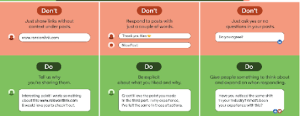LinkedIn Posts: Do’s and Don’ts For Post Interaction
LinkedIn posted a graphic on Do’s and Don’ts for intereacting with posts on LinkedIn in their “Guide to Creating” blog a couple weeks ago. I thought it was worth some discussion.
“Don’t share links without context under posts.” Instead, “Tell us why you are sharing them.”
First of all, some clarification is in order. Almost since posting began on LinkedIn there has been a debate about whether LinkedIn penalizes you for including a link in your post (or article or newsletter when they were introduced). The debate has raged back and forth, but in the end people wanting to play it safe will add a line to their posts saying “there will be a link in the first comment after the post is published*
This is not about that. This is for people commenting on the post. And here is where I veer in an unexpected direction: I am not a fan of posting links to other content in the comments threads of other people’s posts. Quite frankly I think it’s poor form to take people away from the comment thread. Whoever the author of the post was, they worked hard to come up with content that people would find interesting and want to comment on. Adding a link is what I think of as “comment thread hijacking”. Note that this is the opinion of someone who has had this happen a hundred times.
* I use a link to my email newsletter sign up page in every one of my LinkedIn newsletters and it does not appear to affect or harm the distribution of the newsletter in new (non-subscriber) people’s feeds.
“Don’t Respond to posts with just a couple of words.” Instead “Be explicit about what you liked and why.”
Let’s face it, saying something like “I agree.” or “Nice post.” takes just barely more work than pressing “Like.” and means about as much. Whenever you comment on a post, your goal should be to extend the conversation, or add color to a point the author made. This makes you look good too. I have had people start separate conversations with me based on comments I have made. Making solid comments has also gained me followers, profile views and newsletter subscribers. Those types of results make taking a little time to really add to the conversation worth it.
And this is important for another reason too: the LinkedIn algorithm is watching. It is apparent from comments LinkedIn has made about changes to the algorithms last Spring that the algos are now looking for “Meaningful comments”. Meaningful comments will help the author get further distribution of their post.
And this is a bit off topic, but this applies to when you share someone else’s content on LinkedIn. Never do what I call a “naked share” where you just click the share button. Always add an introductory comment. Give the people you are sharing the content with the reason they should read or consume the content.
Don’t just ask yes or no questions in your posts.” Instead, “Give people something to think about and expand on in the comments.”
LinkedIn is referring to your call to action as author of the post. Author’s will often ask “Do you agree?” as their call to action under the assumption that people will agree or disagree but then go on to explain why they agree or disagree. But that the author often gets is a simple yes or no answer.
Of course you could ask “Do you agree or disagree? Please state your reasons.” but that isn’t exactly the most warm and welcoming call to action, is it?
I suggest that a call to action should always be open ended. Things like “Are there aspects that you think I have not considered?” or “What would you add to this list?” Both of those invite discussion.
And let me add something else with respect to calls to action that encourage comments and discussion: if you are in business, especially for yourself, one of the things you’re always looking for (praying for?) from your content is sales leads. And one of the problems with content on LinkedIn is that LinkedIn won’t tell us who reads our content. They will give us some vague demographic info that is largely useless. But when someone adds a good comment, and that person is in your target demographic, as far as I am concerned, that’s a sales lead with three important benefits for you, the author:
- You can identify the person and go look at their profile
- They have shown an interest in something you have written
- This represents a plausible reason for you to reach out to them
If you find someone like this, there are two strategies you can use to contact them.
1. Send them a message. If you have a premium account, you can send them an InMail. If you don’t have a Premium LinkedIn account and they do, they could be Open Profile and you can send them a free message. Or you could both be members of the same LinkedIn Group in which case you can send them a free message.
2. Just invite them to connect. I advocate always including a message, and the message should focus on what’s in it for them.
There are other things you could do like hoping they ask you to connect, or going and viewing their profile repeatedly in the hopes they will ask you to connect, but I am not big on methods that rely on the other person doing something. If there is someone worthwhile I want to connect with or send a message to, as far as I am concerned, It’s up to me to do so.
And that’s my take on LinkedIn’s Do’s and Don’t for post interaction.
